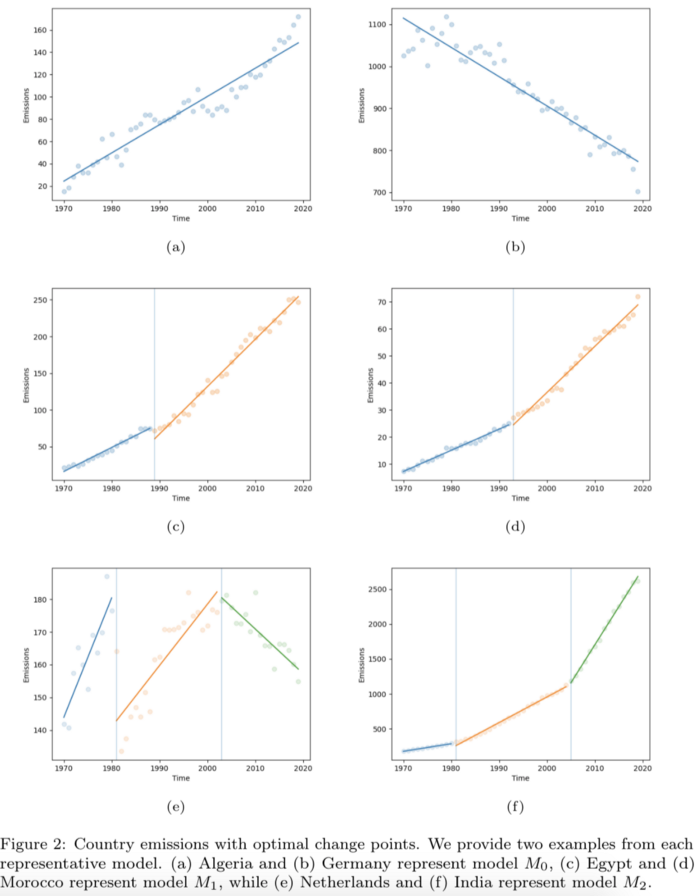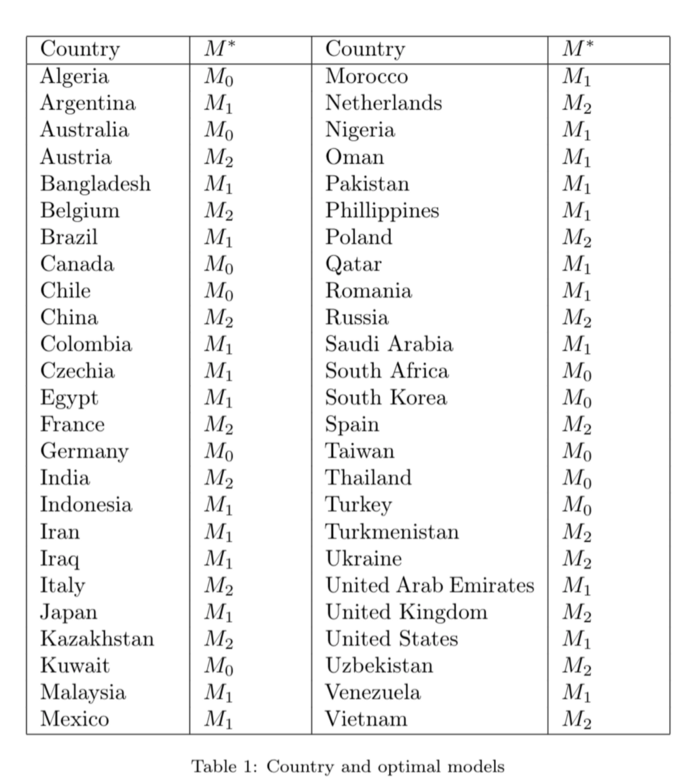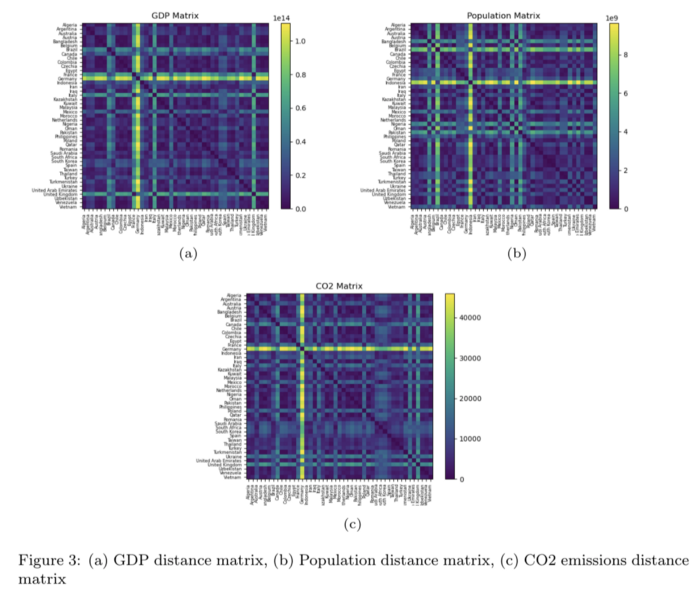In this white paper, we introduce new frameworks to study the spatio-temporal patterns in carbon dioxide emissions, demographic trends, and economic patterns across 50 countries over the past five decades. Our analysis is divided into three sections.
First, we do a decade-by-decade study of carbon dioxide emissions trajectories, demonstrating notable changes in cluster structures for each time period. This highlight shifts between country emissions profiles over time.
Next, we introduce a new method to classify countries into one of three characteristic emissions classes, where countries are categorised according to their number of linear components. Here, we highlight that most countries are best represented by a piecewise linear model with one change point. This suggests that most countries experienced two periods of characteristic emissions during our analysis window.
Finally, we use GDP, population, and carbon dioxide data, and apply dimensionality reduction and clustering to group countries based on similarity in their real and carbon economies. This technique is a new way of viewing similarities between countries, capturing economic and emissions data over 50 years.
Decade-by-decade emissions trajectories
In this section, we investigate country emissions trends on a decade-by-decade basis, exploring the evolutionary structure of country behaviours. Both the number of clusters and cluster constituents are dynamic, with both varying as we proceed forward in time.
First, we take the period from 1970–1979, where we observe a predominant cluster consisting of three sub-clusters, and a small collection of outlier countries (primarily displayed as separate sub-clusters within the predominant cluster). The dendrogram corresponding to this period is shown in Figure 1a. All sub-clusters within the predominant cluster produce increasing trends of carbon dioxide emissions over the decade. The first sub-cluster consists of countries such as Russia and the Ukraine. These countries are characterised by huge growth and accelerating emissions trends. The second sub-cluster, consisting of Italy, Canada, and Argentina, exhibit moderate growth in carbon dioxide emissions. The final cluster which includes countries such as Spain and Brazil also display relatively steady growth behaviours. Countries such as Vietnam and Kuwait exhibit declining carbon dioxide emissions, which is anomalous with respect to the rest of the collection.
Next, we turn to 1980–1989, shown in Figure 1b. This period produces a dendrogram consisting of three distinct clusters. The first cluster contains countries such as India and China, which display continued growth throughout the period. The second cluster consists of a variety of countries but specifically displays pronounced similarities between the Eastern European nations of Kazakhstan, Russia, and Ukraine. These countries all experienced huge growth in emissions, peaking at around 1990. The final cluster consists of France, Belgium, and Nigeria. These countries display erratic emissions behaviours, with all trajectories displaying limited trends and substantial volatility.

In the 1990–1999 period shown in Figure 1c, countries form one primary cluster, with a small collection of outlier countries in a separate, significantly smaller cluster. The primary cluster consists of countries that displayed consistent growth to varying extents over the prior decade. The small outlier cluster consisting of countries such as Kazakhstan, Russia, and Ukraine, all experienced precipitous drops in their emissions at the beginning of the period—and this behaviour continued throughout the remainder of the time period. The latent phenomenon that the cluster formation captures here is the fall of the Iron Curtain in Eastern Europe.
The 2000–2009 period produces one primary trajectory cluster consisting of two similarly-sized sub-clusters, and a collection of outlier countries. The hierarchical clustering results are displayed in Figure 1d. The clear bifurcation in the large cluster is indicative of contrasting trends in emissions behaviours between various countries. The first sub-cluster consists of countries such as the Netherlands, Italy, Germany, the US, Canada, Japan, and Belgium. Most countries within this sub-cluster are more developed and have taken a stronger stance in introducing policies to reduce emissions. Such countries exhibit either flat or declining emissions trajectories throughout the decade. The second sub-cluster consisting of countries such as India, Iran, and Turkey, produce sustained growth in emissions during this period. The significantly smaller second cluster consists of Oman, China, Vietnam, and Qatar, that produce emissions profiles like that of the second sub-cluster.
Finally, we turn to the most recent decade of 2010–2019, as shown in Figure 1e. This period produces three characteristic classes of emissions trajectories. The first cluster consists of countries with lower HDI (human development index) levels: Vietnam, Bangladesh, the Philippines, Iraq, and Pakistan. HDI is a summary metric representing average achievement in various areas of human life. These countries produce emissions trajectories that increase significantly throughout the period.
The second cluster consists of Venezuela, Ukraine, the UK, Italy, and UAE. These countries produce mostly declining trajectories which may represent a greater collective focus on reducing carbon dioxide emissions at the national level. The final cluster consists of two primary sub-clusters. The first contains countries such as Japan, the Netherlands, and Belgium. These countries are primarily characterised by erratic emissions output, with a declining trend overall. The second sub-cluster consists of countries such as China, Thailand, and Chile, that produce a positive trend over the entire decade, with the rate of increase having slowed, and in some cases, overall emissions have begun to trend downward.
Characteristic emissions classes
In this section, we introduce a new method to classify countries based on their emissions trends over time. Having noticed that many countries exhibit a piecewise linear trend in their CO2 emissions, we introduce a new framework to determine the most appropriate model for each country.
We assume that each country’s emissions behaviours over time is best represented by one of the three following models:
Our algorithmic procedure optimises with respect to the number and placement of (up to two) change points, such that our function’s average R² is maximised. We compute average R², taking an arithmetic average of all segments’ R². Given our preference for a simpler model in the case where a more complex one accounts for a similar level (or marginally more) explanatory variance, we introduce a slight penalty for model complexity.

The most frequently occurring model is M_1, followed by M_2, and then M_0. That is, in most cases, carbon dioxide emissions are best modelled with the existence of either one or two change points.

In Figure 2, we display two representative countries for each model. In some cases, such as Algeria in figure 2a and Germany 2b, there is one persistent trend over the past 50 years. For Algeria, there is a consistently positive trend in emissions, while in Germany, emissions are best modelled by a linear decline over the past 50 years.
In the case of Egypt (figure 2c) and Morocco (figure 2d), both countries produce a more strongly positive linear slope beyond the late 1980s and early 1990s. Thus, these phenomena are best modelled with one change point. In the case of the Netherlands and India, as seen in Figures 2e and 2f respectively, both emissions patterns require two change points to model the dynamics.
For the Netherlands, there are obvious discontinuities and abrupt changes in total emissions, seen in the early 1980s and early 2000s. While in India, the early 1980s and mid-2000s display obvious increases in the slope of carbon dioxide emissions.
Identifying similarity in real and carbon economies
Here we introduce a new method to identify countries that share similar economic, demographic, and emissions histories. First, we gather GDP, population, and CO2 emissions data over the past 50 years, and generate distance matrices between all countries for each respective measurement. We then generate an aggregate distance matrix, where each metric is scaled by a constant, such that we normalise for the scale of each metric in our aggregate distance. We then apply multi-dimensional scaling to the distance matrix, projecting the matrix into lower-dimensional data space, and apply K-means clustering to the resulting projection. The number of clusters, K, is determined by optimising the silhouette score. For the sake of interpretability, we accompany these K-means clustering results with a hierarchical clustering dendrogram.

When we apply this analysis to all 50 countries, the USA exhibits highly anomalous behaviour. In fact, we must sWhen we apply this analysis to all 50 countries, the US exhibits highly anomalous behaviour. In fact, we must sequentially remove the US, China, India, Russia, and Japan to identify the general structures without these outlier countries. In the subsequent analysis, we exclude these five and study the structural patterns among the remaining nations.

First, we explore the similarity between countries with respect to each metric individually. Figure 3 displays the three distance matrices for GDP, population, and C02 emissions. In figure 3a, one can see that Germany, France, and the UK are the most anomalous countries with respect to GDP based on their significant economic output over the past 50 years. In figure 3b, we see the distance between country populations, where Indonesia, Brazil, and Bangladesh exhibit the greatest dissimilarity to the rest of the collection. In figure 3c, Germany exhibits the greatest dissimilarity to the remainder of the group.
For the sake of exposition, we present the hierarchical clustering results of our distance matrix capturing similarity in countries’ real and carbon economies. Figure 4 highlights the existence of one prominent cluster, a small sub-cluster, and an outlier.
The primary cluster consists of three sub-clusters, the first of which includes countries such as Chile, Iraq, Vietnam, Romania, Bangladesh, etc. Most countries in this cluster are characterised by developing economies, growth in population, and significant growth in carbon dioxide emissions over time.
The second sub-cluster consists of countries such as the Netherlands, Argentina, Nigeria, Taiwan, etc. These countries typically displayed consistent growth in GDP and population, and lower levels of carbon dioxide emissions over time. The final sub-cluster consists of Spain, South Korea, Indonesia, Mexico, Canada, and Turkey. Most of these countries displayed moderate growth in GDP and population, and growth in carbon dioxide emissions, exhibiting reasonable variability over time.
Many of these countries experienced a flattening in emissions over the final 5–10 years of the analysis window. The second cluster includes the UK, France, Italy, and Brazil. These countries are characterised by increasing emissions trajectories until the later parts of the analysis window, where a flattening or decline in emissions occurs. Germany is identified as an outlier, which is due to its steady decline in emissions over time and the strong GDP growth over the entire analysis window.

This analysis may probe further interesting studies. First, one could explore the key industries and sectors of the economy that drive emissions. This may vary significantly between countries, or perhaps, select industries drive most of the emissions.
Next, one could explicitly study the correlation between population growth and emissions and identify countries that have done the best job in controlling emissions levels relative to their population growth. Figure 5 displays the emissions profile of five major countries: China, the US, India, Russia, and Japan. Basic visual inspection confirms the pronounced similarity between China and India’s emissions profiles, while the US and Japan share broadly similar emissions histories. Russia’s sharp decline in emissions in the early 1990s corresponds to the fall of the Iron Curtain. One could speculate that these emissions are highly related to GDP—and studying this relationship could explicitly provide salient insights.
Conclusion
We apply recently introduced and new methods in spatio-temporal data analysis to identify structural similarity and evolutionary patterns in emissions behaviours over time. First, we demonstrate pronounced heterogeneity in cluster number, size, and constituency among emissions trajectories on a decade-by-decade basis. This section highlights the dynamic nature of this problem and the need for constant monitoring of country behaviours. In the second section of this white paper, we demonstrate that most countries are well-modelled by a piecewise linear data generating process. The consistency of this finding is surprising and would be interesting to monitor moving forward. Should countries more actively police their emissions, one could expect to see further propagation of change points in the near term.
Finally, we introduce a framework to group countries based on their real and carbon economies. Our methodology captures GDP, population, and emissions data over the past 50 years, and includes dimensionality reduction and clustering. This framework could be applied to other problems, or one could generalise some of the questions explored in this paper using different economic and demographic metrics.